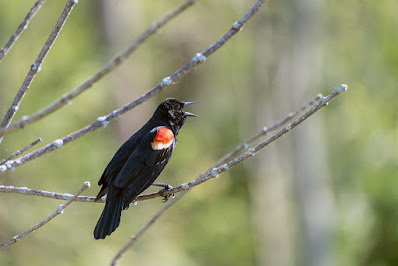Over the past couple of years, I have been learning more about birds and how to help them (involuntarily, as my sister started working at Houston Audubon and became very interested in birds). I have always had a couple of feeders in the backyard, but I started planting native plants, put out a birdbath, and increased the number of feeders I have out.
On Saturday, I saw a post on Houston Audubon's Instagram about how to help birds during the impending winter storm, and decided to take some extra precautions. My backyard shares a fence with a golf course that provides lots of tree cover for the birds already. The back corner of the yard has some bushes and native plants, and provides a nice natural windbreak. On Sunday, I scattered a bunch of black oil sunflower seeds and mixed seeds on the ground and restocked all the feeders. I refilled the feeders twice daily through Thursday and checked in periodically to remove any ice buildup from the intermittent snow and rain. On Monday morning, I noticed the water in the birdbath was frozen, so I chiseled some of the ice off and poured in hot water. I also left out a bucket of hot water, which immediately drew in tons of birds who sat around the steaming water like it was a campfire. The hot water would quickly freeze over so I continued to refresh it twice daily as well. While I'm not skilled at bird identification, I loved seeing the variety of species that these efforts supported. I saw blue jays, cardinals, red-winged blackbirds, grackles, nutmeg mannikins, mockingbirds, warblers, and more. I even had a little squirrel come and claim his own spot in the garden. Despite losing power for a couple of days, these actions seemed simple enough for me to do, and it was very rewarding to see the birds come in droves and enjoy a temporary reprieve from the bitter cold.
On Saturday, I saw a post on Houston Audubon's Instagram about how to help birds during the impending winter storm, and decided to take some extra precautions. My backyard shares a fence with a golf course that provides lots of tree cover for the birds already. The back corner of the yard has some bushes and native plants, and provides a nice natural windbreak. On Sunday, I scattered a bunch of black oil sunflower seeds and mixed seeds on the ground and restocked all the feeders. I refilled the feeders twice daily through Thursday and checked in periodically to remove any ice buildup from the intermittent snow and rain. On Monday morning, I noticed the water in the birdbath was frozen, so I chiseled some of the ice off and poured in hot water. I also left out a bucket of hot water, which immediately drew in tons of birds who sat around the steaming water like it was a campfire. The hot water would quickly freeze over so I continued to refresh it twice daily as well. While I'm not skilled at bird identification, I loved seeing the variety of species that these efforts supported. I saw blue jays, cardinals, red-winged blackbirds, grackles, nutmeg mannikins, mockingbirds, warblers, and more. I even had a little squirrel come and claim his own spot in the garden. Despite losing power for a couple of days, these actions seemed simple enough for me to do, and it was very rewarding to see the birds come in droves and enjoy a temporary reprieve from the bitter cold.
I plan on continuing to take steps to protect birds however I can. The Bird Friendly Houston website is a great resource for learning more about how to support our feathered friends.
By Jaweria Seth





Comments
Post a Comment